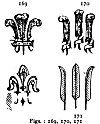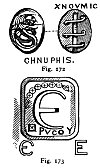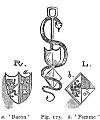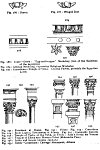
Sacred Texts Sub Rosa Index Previous Next
Buy this Book at Amazon.com

THE. 'Collar of Esses' is supposed always to be a part of the Order of the Garter. The coupled 'S.S.' mean the 'Sanctus Spiritus', or 'Holy Spirit', or the 'Third Person'. The 'Fleurs-de-Lis', or 'Lisses', or the Lilies of the Field', invariably appear in close connexion with St. John, or the 'Sanctus Spiritus', and also with the Blessed Virgin Mary, in all Christian

Click to enlarge
Fig. 168: Collar of Esses
symbola or insignia. The Prince of Wales's triple plume appears to have the same mythic Egyptian and Babylonian origin, and to be substantially the same symbol as the 'Fleur-de-Lis'. When arranged in threes, the 'Fleurs-de-Lis' represent the triple powers of nature--the 'producer', the 'means of production', and 'that produced': The 'Fleur-de-Lis' is presented in a deep disguise in the 'Three Feathers', which is the crest of the Prince of Wales;

Click to enlarge
Figs. 169-171
in this form the Fleur-de-Lis is intended to elude ordinary recognition. The reader will observe the hint of these significant 'Lisses' in the triple scrolls or 'Esses' coiled around the bar in the reverse of the Gnostic gem, the 'Chnuphis Serpent', elsewhere given. This amulet is a fine opalescent chalcedony, very convex on both sides. It is the figure of the 'Chnuphis Serpent' rearing himself aloft in act to dart, crowned with the seven vowels, the cabalistic gift to Man in his Fall, signifying 'speech'. The re verse presents the triple 'S.S.S.' coiled around the 'Phallus'.
In fig. 170 we have the Prince of Wales's Feathers, from the Tomb of Edward the Black Prince, in Canterbury Cathedral. This badge presents the idea of the 'Fleur-de-Lis', 'Ich Dien!'--'I serve!'
Fig. 171 represents the Egyptian Triple Plumes, which are the same badge as the 'Fleur-de-Lis' and the Prince of Wales's Feathers, meaning the 'Trinity'.
Fig. 172--also (ante) referred to as fig. 191--is a Gnostic Gem. It represents the 'Chnuphis Serpent', spoken of above.
A famous inscription (Delphic E) was placed above the portal of the Temple at Delphi. This, inscription

Click to enlarge
Figs. 172, 173
was a single letter, namely, the letter E, the name of which in Greek was E, 'which is the second person of the present of the indicative of the verb ειμι, and signifies 'Thou art'; being as Plutarch has interpreted it, the salutation bf the god by those who entered the Temple. See Plutarch de E apud Delph. Lord Monboddo's Origin and Progress of Language (1774), vol. ii. p. 85, refers to this letter E.
The Delphic 'E' means the number 'Five', or the half of the Cabalistic Zodiac, or the Five Ascending Signs. This 'Delphic E' is also the Seleucidan Anchor. It was adopted by the Gnostics to indicate the 'Saviour', and it is frequent in the talismans and amulets of the early Christians. It is one of the principal gems of the Gnostics, and is a cameo in flat relief.
One of the charges against the Knights Templars was as follows: 'That they bound, or touched, the head of an idol with cords, wherewith they bound themselves about their. shirts or next their skins'
[paragraph continues] ('Processus contra Templarios', Dugd. Monast. Ang. vol. vi. part ii. pp. 844-846, etc.). There is something strange about these cords, cordons, ropes, belts, bands, baldrics (also in the term 'belted earls'). These are always male accessories; except the 'zones', sashes, or girdles, worn as the mark of virgins, which cinctures may yet draw their symbolic meaning from this same 'umbilicus' in question. The reader will notice also the connexion of these ideas and the practice in the Roman race of the 'Lupercal', at the February Roman religious solemnities (February of the 'Fishes'). At these it was the custom of the runners to flog bystanders, particularly women, with thongs or cords; which were probably intended to be the racers’ own girdles. Julius Cæsar, Mark Antony, and Calphurnia form a group illustrative of this meaning. Thus Shakespeare:
Is this the origin of the custom of the people pelting or .flogging each other at the Italian Carnivals? It seems highly probable. The Carnivals occur at the same time as these Roman Lupercalia.
Many early Norman mouldings exhibit various examples of the cable. Thongs, ties, and network are seen to bind all the significant figures in the early English and Irish churches. Is there any connexion between these bonds, or ties, or lacings, with the 'cable-tow' of the initiates among the Masons? Perhaps the 'tow' in this 'cable-tow' means the 'Tau', or stood for it originally. Reference may here be made to the snake which forms the girdle of the Gnostic 'Good Shepherd' in the illustration later in our book (fig. 252).
The cable-mouldings in Gothic architecture are intended to carry an important meaning. They are found in the pointed or Christian architecture in continual close connexion with the triplicated zigzag, the vandykes, or 'aquarii', as we designate them, because all these architectural forms, which are hieroglyphs, mean the feminine or 'Second Principle', and express the sign of Aquarius, with its watery or lunar hints, its twin-fishes, and its Jonah-like anagrams of the 'Redeemer'. Hence the boatlike, elongated, peculiar form called the vesica piscis, which is the oblong shuttle-shaped frame continually set over doors and windows and elsewhere in Gothic churches, to contain effigies of the Saviour, or Virgin Mary, or groups from the New Testament in connexion with these Two Sacred Persons. A doorway in Barfreston Church, Kent, supplies an excellent example of the employment of this oblong figure; which is also Babylonian, and means the female member as its starting-point.
In a previous part of our book we give various figures of the prows or cutwater-heads of gondolas, in which we clearly show the origin of their peculiar form, which represents the securis, or 'sacrificial axe', that crook originally expressed in the 'hook of Saturn'. The 'Bu-Centaur' indicates the fabulous being, the bicorporate 'ox' or 'horse' and 'Man', as will be found by a separation of the syllables 'Bu-Centaur'. It is the name of the state-galley of the Doge of Venice, used on the occasion of his figurative stately marriage with, the Adriatic, or espousal of the 'Virgin of the Sea', who was Cybele of the 'sacrificial hook'. The hatchet of Dis, the glaive, the halberd, the reaping-hook of Ceres, the crescent moon, the 'Delphic E', are all the same mystic figure. The prow of the gondola exhibits unmistakably the
securis and fasces conjointly, or the axe of the sacrifice and the rods for the scourging of the victim first, if human, and afterwards for his burning--the rods being the firewood. Lictors have their name probably from 'Llec'. From this peculiar cutwater arose the Dragon-beak, the 'Prow', or 'Frow', the figurehead and fiddle-head. They have all a feminine origin.
Fig. 174 represents 'S. Johan' (St., John), from an early woodcut of the Twelve Apostles: His right hand is raised in the act of the holy sign, whilst hid left clasps the chalice of the 'S.S.', or Sacrament of Wine; in the cup is a salamander, signifying the 'H. G'. This is St. John the Apostle, the author of the 'Apocalypse'; or the 'Sanctus Spiritus', who baptizes in the mystic Eucharist with the 'Holy Ghost and with Fire'.
The following are the names pf the angels of the planets, according to the Gnostics. At the beginning of all things is Jehovah (Sabaoth), Victory; at the end, the 'Old Serpent' (Ophis). Between these are the Seraphim (Intelligences) and Cherubim (Benevolences), and their representatives. Origen calls the Sun, Adonai; the Moon, Iao; Jupiter, Eloi; Mars, Sabao; Orai, Venus; Astaphai; Mercury;
[paragraph continues] Ildabaoth, Saturn. All this is Gnostic--highest mysticism therefore.
The name Tarasque is given for the Dragon of a Northern Nation. (Qy. the 'Hill of Tara', etc.?) Under the Roman Emperors, and under the Emperors of Byzantium, every cohort or centurion bore a dragon as its ensign (Modestus, De Vocabul. Rei Milit.; Flav. Veget. De Re Militari, lib. ii. c. xiii.: Georget, Insig. Europ., loc. cit.) Matthew of Westminster, speaking of the early battles of this country of England, says: 'The King’s place was between the Dragon and the Standard'--'Regius locus fuit inter draconem et standardum' (Lower's Curiosities of Heraldry, p. 96). This is the undoubted origin of the ensign’s 'pair of colours' in a battalion; viz. the first colour, or 'King’s Colour', whose place is to the right, is properly the standard; and the second colour, or the 'regimental colour', to which is assigned the left-hand, or female, or sinister place, is the 'Dragon'. The Dragon was supposed to conduct to victory, because its figure was a most potent charm. The standards and guidons of the cavalry follow the same magic rule.
The planets are supposed by the astrologers and alchemists to exercise dominion more particularly in the order following, and to produce effects upon their own appropriate under-mentioned metals, on planetarily corresponding days. These are Sol, for gold, on Sunday; Luna, for silver, on Monday; Mars, for iron, on Tuesday; Mercury, for quicksilver, on Wednesday; Jupiter, for tin, on Thursday; Venus, for copper, on Friday; and Saturn, for lead, on Saturday (Lucas's Travels, p. 79; Count Bernard of Treviso). The emblematical sculptures, in which the whole enigma of the art of transmutation is supposed to be contained, are those over the fourth arch of the
[paragraph continues] Cemetery of the Innocents, at Paris, as you go through the great gate of St. Denis, on the right-hand side. They were placed there by Nicholas Flamel.
The old traditions, from time immemorial, aver that it is neither proper for sailors nor for servants of the sea to wear beards. That they have never done so is true, except at those times when profound mythic meanings were not understood or were neglected. This smoothness of a sailor's face arises from the fact that the sea has always been mythologically feminine, and that sailors and men or followers of the sea are under the protection of the 'Queen of the Deep', or the 'Virgin of the Sea'. Hence the figure of Britannia, with her sceptre of the sea or trident, and not that of Neptune.
The Virgin Mary, the 'Star of the Sea', and Patroness of Sailors, rules and governs the ocean, and her colours are the ultramarine of the 'Deep', and sea-green, when viewed in this phase of her divine character. In all representations, ancient or modern, sailors have beardless faces, unless they belong to the reprobate and barbarian classes--such as pirates and outlaws, and men who have supposedly thrown off devotional observance, and fallen into the rough recusancy of mere nature.
Fig. 175 is a very curious design from Sylvanus Morgan, an old herald. Above is the spade, signifying here the phallus; and below is the distaff, or instrument of woman's work, meaning the answering member, or Yoni; these are united by the snake. We here perceive the meaning of the rhymed chorus sung by Wat Tyler's mob: 'When Adam delved' (with his spade), 'and Eve span' (contributing her [producing] part of the work), 'where was then the Gentleman?'--or what, under these ignoble conditions, makes difference or degree? It is supposed
that Shakespeare plays upon this truth when he makes his clown in Hamlet observe 'They' (i.e. Adam and Eve) 'were the first who ever bore arms.' By a reference to the foot of the figure, we shall see what

Click to enlarge
Fig. 175. a. 'Baron' b. 'Femme'
these arms were, and discover male and female resemblances in the shape of the man’s 'escutcheon' and the woman's diamond-shaped 'lozenge'. As thus: a is the shield of arms, or 'spade', or 'spada', or 'male implement', on man’s own side, or dexter side; b is the 'lozenge', or distaff, or 'article representative of woman's work', on her proper side, or the left or sinister side.
A chalice is, in general, the sign of the Priestly Order. The chalice on the tombstone of a knight, or over the door of a castle, is a sign of the Knights Templars, of whom St. John the Evangelist was the Patron Saint. The 'cup' was forbidden to the laity, and was only received by the Priests, in consequence of the decree of Pope Innocent III, A.D. 1215. It means the 'S.S.', or Holy Spirit, to which we have frequently adverted.
We have carefully inspected that which has been designated the crux antiquariorum, or the Puzzle of
[paragraph continues] Antiquaries, namely, the famous Font, which is of unknown and bewildering antiquity, in the nave of Winchester Cathedral. Milner (a feeble narrator and misty, unreliable historian), in his History of Winchester, has the following superficial notice of this relic: 'The most distinguished ornaments on the top are doves "breathing"' (they are not 'breathing', they are drinking) 'into phials surmounted with crosses fichée. And on the sides' (the north side, he should say, which is faced wrongly, and ought properly to front the east) 'the doves are again depicted with a salamander, emblematic of fire; in allusion to that passage of St. Matthew: "He shall baptize you with the Holy Ghost and with fire".'
All the secrets of masonry are concealed in the Hebrew or Chaldee language. In the First Chapter of the Gospel according to St. John is contained the mythical outline of the Cabala, in its highest part.
'Les anciens astrologues, dit le plus savant les Juifs' (Maimonides), 'ayant consacré à chaque planète, une couleur, un animal, un bois, un métal, un fruit, une plante, ils formaient de toutes ces choses une figure ou réprésentation de l’astre, observant pour cet effet de choisir un instant approprié, un jour heureux, tel que la conjonction, ou tout autre aspect favorable. Par leurs cérémonies (magiques) ils croyaient pouvoir faire passer dans ces figures ou idoles les influences des êtres supérieurs (leurs modèles). C’étaient ces idoles qu’adoraient les Kaldéens-sabéens. Les prêtres égyptiens, indiens, perses--on les croyait lier les dieux à leurs idoles, les faire descendre du ciel à leur gré. Ils menacent le soleil et la lune dé révéler les secrets des mystères.'--Eusebius Iamblicus, De Mysteriis Egyptiorum.
The mystic emblems of the religions of India, China, Greece, and Rome are closely similar, and are
set forth in the ornaments on the friezes of the temples of all those countries, explaining their general principles. 'Your popular societies are an emanation from the lodges of the Freemasons; in like manner as these proceeded from the funeral pile of the Templars' ('Castle' of the Tuileries, year viii). Thus the 'egg-and-tongue moulding ('egg and adder's tongue', for the egg and the serpent were two of the emblems of the Egyptian and Greek mysteries), the griffin, the lion of St. Mark, the honeysuckle-and-lotus ornament, the convolutions and volutes, the horns as floriation springing from the lighted candelabra, the lotus and tori of Egypt, and the Greek ornaments and Roman Templar ornaments, are all related in their religious meanings.
The names of the 'Three Kings', or 'Shepherds'; who descried, the Star of Annunciation in the East, are Caspar, Melchior, and Balthasar. Caspar, or Gaspar, is the 'White One'; Melchior is the 'King of Light'; Balthasar, the 'Lord of Treasures'. Balthasar, or Balthazar, is the Septuagint spelling of Belshazzar.
Linga is the old name of an island near Iona, called the 'Dutchman's Cap'. (Qy. the Phrygian cap?--also the first 'cocked hat', and its recondite meaning?) Gallus, or the Cock, is sacred to Mars, whose-colour is red. In this connexion, and as bespeaking Hermes or Mercurius, the 'messenger of the dawn', may have arisen the use of the 'cock', as the emblem supposedly of the first descrier of the daily light from the tops of the steeples. It probably signifies the phallic myth. The grasshopper, dragon, arrow, and fox, as weathercocks, have undoubtedly a remote reference to the same idea of symbolizing the 'Prince of the Powers of the Air'.
The form of the Pointed Arch reached the Orientals
[paragraph continues] --as we see in their Temples--in the shape of the Phrygian and Median Bonnet (Lascelles, 1820). In these strange curves we have mingling the scarab, scorpion, Σ, or (--).
Cocks crow at day-dawn. Weathercocks turn to the wind, and invite the meteoric or elementary influences, the 'Powers of the Air'. The question as to the mystic side of all this is very interesting and curious. The fields of the air were supposed by the Rosicrucians to be filled with spirits.
'Tous les Lamas portent la mitre, ou bonnet conique, qui était l’emblème du soleil. Le Dalai-Lama, ou immense prêtre de La, est ce que nos vieilles relations appelaient le prêtre Jean, par l’abus du mot persan Djehân, qui veut dire le monde. Ainsi le prêtre Monde, le dieu Monde, se tient parfaitement.'--Volney, Ruines, p. 251. (Qy. Prester-John? Qy. also this verbal connexion with 'Saint John', as if Prêtre John?) In the old Norman-French Maistre is frequently met for Maître. This Prestre, or Prester (Anglicized), or Prêtre John, is probably no other than the Priest or High-Priest 'John', otherwise Saint John, or the 'Saint-Esprit'. The recognition of the + in the Great Llama, Al-Ama, Ama, Anima (Soul, Spirit), Alma, El-Om, etc., meaning 'white', is very curious. The antiquary Bryant is positively of opinion, from the very names of Columbkil and Iona, that this island Iöna was anciently sacred to the Arkite divinities. The great asylum of the Northern Druids was the Island of Hu or Iona, Vs Colan, or Columba (Mythology and Rites of the British Druids, by Edward Davies, 1809, p. 479).
The glories around sacred persons and objects, which have straight-darting and curvilinear or wavy or serpentine rays alternately, are continual in theological or heraldic illustration; which waved and straight
rays alternately imply a deep mystery. They are constant symbols in the sacred nimbi, and are found upon sacramental cups; they are set as the symbolical radii around reliquaries, and they appear as the mystic fiery circle of the Pyx. The straight spires and the brandished waved flames, or cherubic (or rather seraphic) gladii, or crooked swords guarding Paradise, imply two of the chief Christian mysteries. In the curved spires of flame, alternating with the aureole or ring of glory, there is possibly a remote hint of ♄, or the 'Reconciler of the Worlds Visible and Invisible', or 'S.S.'.
To account for the universal deification of 'horns' in architecture all over the world, as its symbolic keynote, as it were, which sigma has been transmitted into modern emblematic science, and incorporated unconsciously into the ornaments and elevated into the high places, over and over again, even in Christian buildings, an old Talmudist--Simeon Ben-Iochay by name--hazards the startling conjecture that this adoration arose originally in the supernatural light of knowledge of the old day, for the following reasons: the strange explanation which this mysterious writer gives is, that the bovine animals would have themselves become men in their future generations, but for that divine arrest which interfered athwart as it were, and wasted the ruminative magnetic force; which otherwise miraculously would have effected the transformation, by urging the powers of the brain from the radix of the rudimentary templar region into the enormous branching, tree-like, then improvised appendages, where this possibility or extension of the nervous lines became spoiled and attenuate, solidified and degraded. Growth and development are assumed as taken from expansion and radiation off a nervous sensitive centre, by election or affinity governed by an

Click to enlarge
Figs. 176-179
|
Fig. 176: The Templar Banner, 'Beauséant' |
invisible Power operating from without. It is to descend very deep into cabalistic and Talmudical mysteries to gain comprehension of an idea concerning-the origin of this absurd worship of animal horns.
The cabalist Simeon Ben-Iochay declares that it was in gratitude for this changed intention, and because the creature man became 'Man', and not the bovine creatures--a 'catastrophe which might have happened, except for this diversion of the brain-power into horns' (mere fable or dream as all this sounds!)--that the Egyptians set up the very 'horns,' to worship as the real thing--the depository or 'ark'--into which the supernatural 'rescue' was committed. Thus the horns of the animal--as the idol standing for the means, equally as another representative figure (the phallus), expressive of the mighty means to which man’s existence and multiplication was entrusted--were exalted for adoration, and placed as the trophies heroically 'won even out of the reluctance and hostility of nature',

Click to enlarge
Figs. 180-185
|
Fig. 180: Knights of Malta; Fig. 181: Cross Potent, Knights Hospitallers; Fig. 182: St. John. (Hospital of St. Cross, Winchester); Fig. 183 Egyptian Torus, Lotus Enrichment, and various Lunar Symbols; Fig. 184: Temple of Apollinopolis Magna, in Upper Egypt; Fig. 185: Norman Capital, Door-shaft: Honeysuckle-and-Lotus Ornament, early example. |
and adored, not for themselves, but for that of which they spoke.
Shakspeare has several covert allusions to the dignity of the myth of the 'Horns'. There is much more, probably, in these spoils of the chase--the branching horns or the antlers--than is usually supposed. They indicate infinitely greater things than when they are only seen placed aloft as sylvan trophies. The crest of his late Royal Highness Prince Albert displays the Runic horns, or the horns of the Northern mythic hero. They were always a mark of princely and of conquering eminence, and they are frequently observable in the crests and blazon of the soldier-chiefs, the Princes of Germany. They come from the original Taut, Tat, Thoth, Teat, whence 'Teuton' and 'Teutonic'. These names derive from the mystic Mercurius

Click to enlarge
186-199
|
Fig. 186: Uræon |
[paragraph continues] Trismegistus, 'Thrice-Master; Thrice Mistress'--for this personage is double-sexed: 'Phoebe above, Diana on earth, Hecate below.'
Fig. 177, ante (from the arches of the Temple Church, London), is a symbol of the 'Blessed Virgin; it is also the 'Delphic E', or 'Seleucidan Anchor'.

Click to enlarge
Figs. 200-202
|
Fig. 200; Norman Capital: Foliated Ornament, resembling the Honeysuckle and Lotus; Fig. 201: Canterbury Cathedral: Volutes of the Corinthian form; Fig. 202: Canterbury Cathedral: Corinthian Scrolls or Horns. |
The 'horns' of the Talmud account for the mythological Minotaur, the Bucentaur, Pan and Priapus, the 'Sagittary' or Centaur, the sign 'Sagittarius', and perhaps all bicorporate human and animal forms.
In the group of figures above, showing the various classical forms of the volutes, or flourished horns, in the Corinthian, Ionic, and Composite capitals, a close affinity will be remarked to examples of capitals with horns or volutes from the temple of Ellora, in India, and other Indian and Persian temples: placed under, for comparison, in the illustration.
Various mouldings, both Gothic and Classic, present shapes drawn from the astronomical sign 'Aquarius'. These signs, or ciphers, are significant of the 'Sea' and of the 'Moon'. Glyphs resembling 'fishes' mean Iona, or Jonah. They are also symbols of the 'Saviour', when they occur amidst the relics left by the early Christians, and in forms of the first Christian centuries.